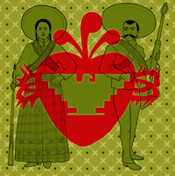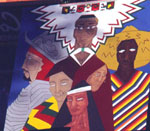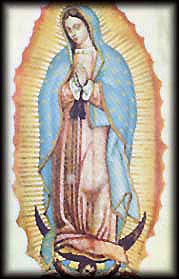


Chicano Movement Art: “Un Nuevo Arte del Pueblo”
From the 1960s on, public arts were the most visible form of Chicano art. According to Holly Barnet-Sanchez and Eva Cockcroft, editors of the book Signs From The Heart: California Chicano Murals, “ a truly ‘public' art provides society with the symbolic representation of collective beliefs as well as a continuing re-affirmation of the collective sense of self.” 21 Artistic expressions from the movement included murals, posters, films, and street processions and performances. They served as a means of educating a largely illiterate populace about their cultural and political identity and the fight for civil rights and social justice. 22 Art was an important organizing tool and means for the Chicano reclamation of their specific cultural heritage. Instead of conforming to the role of art as a commodity and means of escape, Chicano art objects were meant to provide aesthetic pleasure as well as an education to its people. 23
Creating an Art for the People
Chicano artists rejected the “high art” world of museums and galleries, realizing that this world would exclude most of its targeted audience. Instead, they opted for murals, billboards, posters, and new forms of communal ceremonies that would serve as a visual means that could be “commonly understood and collectively validated” by the Chicano people. 24
Chicano art, in an attempt to reflect a multi-cultural reality, united elements from both Mexican and Anglo American artistic traditions. Rather than attempting to distinguish between “fine art” and “folk art,” artists eliminated these boundaries and integrated categories.
Cultural practices of daily life served as prime constituent elements; customs, traditions, and rituals of the barrio presented artists with endless sources of imagery. Since the Catholic religion is such an important influence in the lives of many Chicanos, it is only natural for artists to draw upon religious images and practices, especially estampas and altares. Estampas are sold in stores or are distributed by churches and other religious organizations. They vividly portray popular religious images like the Sacred Heart of Jesus, the Holy Child of Atocha, and the Virgin of San Juan of the Lakes. 25 These images stood in almost every room of Chicano households and the saints portrayed were often regarded as cultural heroes. Artists were also influenced by the altar-making tradition of Chicano people. Altars, or home religious shrines, were part of daily life and typically consisted of crocheted doilies, embroidered cloths, family photographs, personal mementos, or religious images especially exalted by the family. Altars were physical manifestations of cultural and spiritual statements of the people. 26
The Chicano artistic movement expressed the growing sense of Chicano-Native American unity in several ways. The first was imagery of pre-Columbian Indian civilizations. Thousands of depictions of pyramids, Aztec and Mayan princes and princesses, warriors, elitist religious symbols, and temples permeate Chicano visual arts. Artists glorified Aztec gods and emperors like the Aztec Cuauhtemoc and the Toltec ruler Quetzalcoatl. According to Goldman and Ybarra-Frausto, this is a romantic and heroic “affirmation of heritage in the extinguished past”. 27 In this reclamation of indigenous roots, we encounter the concept of Aztlan.
During the UFW movement, two strong visual symbols emerged, used in every procession and manifestation, which became central to Chicano arists: the Virgin of Guadalupe and the red, black, and white thunderbird flag. 28 These potent cultural and political symbols often appear with images of heroic figures such as Ernesto “Che” Guevara and Cesar Chavez. 29

http://www.devocionario.com/imagenes/guada3.jpg
The Virgin of Guadalupe, Virgen de Guadalupe, is said to have appeared to the converted Aztec Indian Juan Diego on Tepeyac Hill and in doing so bridged two worlds -- that of the Aztecs and the Spanish conquerors. She has since become the patron and symbol of Mexico, a country born of this fusion of cultures. The image of the Virgin of Guadalupe has become an unofficial national symbol and many Mexicans proudly proclaim themselves Guadalupans. 30
Through this realm of public art, Chicano artists were able to achieve a national character and cohesiveness that justifies the word “movement.”